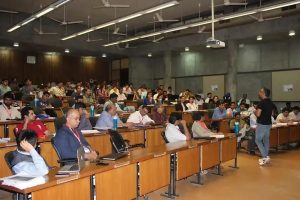The Who and What of the Idea Landscape in India
“If I have a thousand ideas and only one turns out to be good, I am satisfied” — Alfred Nobel
“Capital isn’t that important in business. Experience isn’t that important. You can get both of these things. What is important is ideas.” — Harvey Firestone
The third edition of Power of Ideas, a program conceived by the Economic Times, was hosted by IIM Ahmedabad’s Centre for Innovation Incubation and Entrepreneurship in October 2015. The program invites ideas from all people. Department of Science & Technology, Government of India, provides seed funding and cash grants to the selected ideas. In 2015, the program attracted 19,000 ideas. This article describes our analysis of the 19000 submitted ideas towards who were the idea givers, what were there backgrounds and what were the ideas about.

Where did these ideas come from?
Largely speaking, young, inexperienced males, from affluent homes with no family background in business, constituted the bulk of the idea givers. Thirty percent of the ideas came from people in the age group of 19 to 27. Three quarters of the applicants had less than one year of work experience. Seventeen percent of the applicants had a family member who was an entrepreneur, or were from a “business family.” Only 11% of the applicants were female. Idea givers were mostly (65%) from income of >Rs.2,00,000 households of India.
Almost half (i.e. 47.56%) of the ideas came from Tier-1 cities, which are the six metros of Delhi, Mumbai, Bangalore, Chennai, Hyderabad and Kolkata. Twenty eight percent of the ideas were from Tier-2 cities (including Ahmedabad, Pune, Surat, Kanpur, Indore, Jaipur, Vadodara, Nagpur, Lucknow, Patna, Bhopal, Nashik, Aurangabad and Gandhinagar), with Pune, Ahmedabad, and Jaipur accounting for about half of the Tier-2 city ideas (i.e. 14.35%). Among states, Maharashtra was the biggest generator of ideas; within the state, Mumbai and Pune alone generated 79% of the ideas. Gujarat and Punjab, states conventionally considered entrepreneurial, contributed to only 7% and less than 1% of the ideas, respectively. The lack of ideas originating from several states was glaring. As many as 21 states, including Kerala and Odisha, each generated less than 1% of the ideas. There was not a single idea entry from the states of Nagaland and Mizoram and the Union Territory of Daman-Diu.
Economic and social development, and idea generation
Using the district as the unit of analysis, we examined whether financial inclusion, number of schools/colleges, literacy rate, degree of electrification, computers with internet, and the number of shops and offices were correlated with the number of ideas generated. The literacy rate and the number of schools and colleges per district were positively correlated with the number of ideas generated. Districts with less than 60% literacy showed a sharp decline in the number of ideas submitted. Supporting infrastructure such as electrically well-connected districts and availability of computers with Internet connection was positively related to the number of ideas. Financial inclusion (such as availability of banking services) was weakly correlated and the number of shops/establishments moderately correlated.
What kinds of ideas were generated?
Among a random sample of 404 ideas, 84% addressed a problem in the technological and professional services; only 3% of the ideas catered to the primary sector, mainly agriculture.
About 80% of the ideas targeted the needs of the end customers (B2C); the remaining catered to the needs of a business (B2B). Most of the ideas in the B2C space focused on making life or business easy for the customer; examples included online shopping apps and education focused solutions. A little over 5% of the ideas were related to education/skills. Four percent targeted niche/luxury segments. Three percent of the ideas were related to waste-management. Less than 1% of the ideas catered to social/developmental needs.
Conclusion
The number 19,000 submitted ideas seems impressive in terms of the enthusiasm towards solving problems to start businesses. However, our analysis shows that not only are the idea generators fairly homogeneous, but also the problems that they aim to solve are similar. The climate for having more broad-based participation and democratization of business creation could not be more suitable — there is encouragement, funding, and incubators. However, people with diverse backgrounds, seeking to address a diversity of problems, have to begin thinking creatively if we are to exploit the opportunity of creating shared value for individuals, business, and society.
The starting point for making significant progress towards having a vibrant start up environment and subsequent success is the generation of ideas by millions of people. Many would be good ideas others will be non-starters, many will progress and others will fall by the way side, many will find the funds and others will fizzle out because of lack of funds, and many will develop solutions and products that will be valued by the customers and the others will be rejected. Thus it would be useful for us to brainstorm and find ways to figure out how do we reach a wider, more diverse audience so as to attract a variety of ideas? How do we publicise a national level idea challenge such as Power of Ideas to broad-base its reach? How can we attract ideas from those with diverse backgrounds and experiences?
